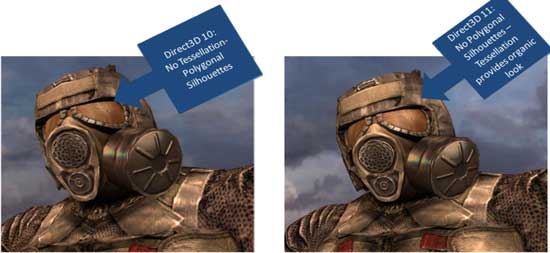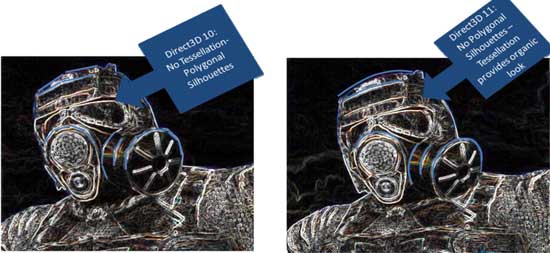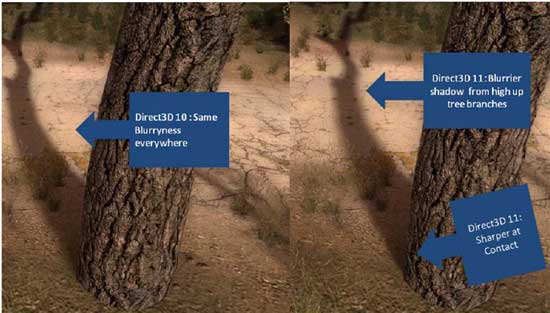The Radeon HD 5970: Completing AMD's Takeover of the High End GPU Market
by Ryan Smith on November 18, 2009 12:00 AM EST- Posted in
- GPUs
STALKER: Call of Pripyat – A Peak at More DX11
For the 5970 launch, AMD sent over a special benchmark version of STALKER: Call of Pripyat, which has since then been made public at the GSC Game World STALKER website. STALKER is another one of AMD’s big DX11 titles, as it’s technically the 2nd DX11 title to launch and the first such title to implement most of the major DX11 features. The Russian version actually shipped back in October, and the German version shipped 2 weeks ago. However we’re told that these versions only had an early-stage implementation of the DX11 feature set, and that the demo is more representative of where the game is after patching and what it will be like when it finally launches in the rest of the world early next year.
Since it’s an unplayable demo, we’re going to forgo any competitive benchmarking (it’s not as if anyone else has a DX11 card anyhow) but we will look quickly at the performance impact of these features, since this is the closest thing we have to a playable game using them at this point in time.
STALKER makes use of 3 major DX11 features.
- High Definition Ambient Occlusion using compute shaders
- Tessellation
- Contact hardening shadows
We’ve already seen HDAO with Battleforge, and it’s no different here in STALKER. And we’ve covered tessellation in-depth in our look at DirectX 11.
So today, let’s talk about contact hardening shadows. Shadowing has been on a path of particularly noticeable evolution. The first real shadows, seen in such titles as Doom 3, had very hard edges. Stencil buffering was used to determine where a shadow would fall, and that was it. Diffusion was never taken into account. Newer games have since taken diffusion into account to generate soft shadows, but these shadows aren’t necessarily accurate. Currently soft shadows are implemented with a fixed degree of softness around the entire shadow, which isn’t how shadows really work.
With diffusion, the softness of a shadow increases with the distance of the casting object from the surface the shadow is being displayed on. AMD loves to use a light pole as an example, as the top of the shadow should be softer than the bottom. These shadows are referred to as contact hardening shadows, and the use of them in games has been limited by the expense of calculating them using the DX10 feature set. STALKER allows for contact hardening shadows with DX10.1 and DX11 mode.
Unfortunately a moving benchmark makes for a poor source to take screenshots, so we’re going to stick with AMD’s reference shots here. Only contact hardening shadows are particularly noticeable in the benchmark; tessellation and HDAO are there, but are virtually impossible to catch given the zoomed-out nature of the benchmark and the fact that it’s constantly in motion.
The benchmark comes with 4 different flybys, each under different environmental conditions: day, night, day with rain, and day with sun shafts. We’ve gone ahead and benchmarked the game during the “day” flyby, once with the DX11 feature set enabled, and once with it disabled. This means for DX11 mode tessellation, contact hardening shadows, and Ultra HDAO were enabled; and for DX10 tessellation and contact hardening shadows were disabled, and High HDAO was used.
| STALKER: Call of Pripyat, Day Benchmark | DX10 | DX11 |
| Average FPS | 31.4 | 35.1 |
| Minimum FPS | 17.7 | 21.2 |
Enabling all of these features actually causes performance to rise, thanks to the more efficient implementation of HDAO as a compute shader as opposed to a pixel shader. Ultimately what this means is that unless HDAO is disabled entirely, STALKER is going to be faster on a DX11 card running the entire DX11 feature set than it will be when running the DX10 feature set.
The biggest performance hit, and the reason we’re not breaking 40fps here even with a 5970, is due to how anti-aliasing is implemented in STALKER. As it uses deferred rendering, the game does its own anti-aliasing. We used 4X MSAA here along with per-pixel alpha transparency testing (basically Adaptive/Transparancy AA). Disabling anti-aliasing improves performance dramatically.













114 Comments
View All Comments
Zool - Wednesday, November 18, 2009 - link
So yes. The answer is that the gpu is doing less work with vsync than without it.(dam still no edit button)Yojimbo - Wednesday, November 18, 2009 - link
The plural for a casting/shaping instrument "die" is "dies" not "dice."Lennie - Wednesday, November 18, 2009 - link
I am going to post this again here. Thought it may not get noticed since I posted it first as a reply in previous pages. Hope I wont hurt anyones feelings :)I thought everyone knew about Furmark and ATi by now. It used to be like this on 4870 series too.
It went like this, at first there were few reports of 4870(X2) cards dying when running Furmak. Further investigation showed that it was indeed Furmark causing VRM's to heat up to insane levels and eventually killing them. Word reached ATi from that point on ATi intentionally throttles their card when detecting Furmark to prevent the damage.
Yeah in fact the amount of heat load Furmak puts on VRMs is unrealistic and no game is able to heat up the VRMs to the level Furmark does. OCCT used the same method (or maybe even integrated Furmark) to test for stability (in their own opinion ofc)
So beware about Furmark and OCCT if you have HD4K or 5K.
The term "Hardware Virus" is rightfully applicable to Furmark when it comes to HD4K (and 5K perhaps)
Lennie - Wednesday, November 18, 2009 - link
I want to add that VRM overheating is quite tricky, since normally people only check on GPU temps.When you run Furmark you would notice that GPU temps are in acceptable range while at the same time your VRM's are cooking without you knowing about it.
So remember to always check your VRM temps when running graphics stability tests like Furmark or OCCT's graphics test specially when you're overclocking the card.
I use Riva or Everest to check on VRM temps.
Rajinder Gill - Thursday, November 19, 2009 - link
The temp reading that is displayed by Everest is an averaged figure. The junction temp of the slaves is the critical issue. Even though the average temp may appear to be within bounds, there is the possibility that one of the slaves may be running abnormally. Volterra keep their specifications under NDA. What I do know is that the general configuration if one slave shuts down is that the remaining slaves take the load. The result is not usually pretty. I think ATI may have implemented throttling to prevent the kind of burnouts users experienced running OCCT GPU tests on the last gen.Personally, I think the 3 phase Volterra solution used on the 5970's is right on the hilt for current draw (circa 135 amps per GPU). I'd wait for non reference solutions with enhanced power delivery if you plan on overclocking this card long term or plan to stress it heavily when OC'd).
Later
Raja
Rajinder Gill - Thursday, November 19, 2009 - link
I should add that I'm assuming ATI used the biggest Volterra slaves rated at 45 amps each and not the 35/40 amp varieties.thebeastie - Wednesday, November 18, 2009 - link
Any one that has a clue is buying a proper case like the Storm Sniper Black Edition and fitting this with heaps of space to spare.Also I recommend a case with positive or at least neutral are flow.
The storm sniper has a dust filter on its 20cm side fan to push more air in and aid in the GPU fans air flow that will go out the back of the cards vent holes at the DVI ports.
at80eighty - Wednesday, November 18, 2009 - link
Plan on getting one of these in another 7-8 months - The way I see it, despite being bleeding edge - ATI has a deadlock winner in this card and will produce only limited quantities so I'm kind of 'worried' about the availability & price down the lineSilverforce11 - Wednesday, November 18, 2009 - link
Wait til the end of December. Apparently the yeilds of cyrpress are going to be improved a lot then, so the prices will either remain the same or be lower a bit.However, since nV has nothing real for a long time, i dont foresee a drop in prices on ATI parts. Given the estimates, NV will have fermi out in april 2010, but not in significant quantities for a while after that. Im gonna grab a 5970 around xmas. :)
at80eighty - Wednesday, November 18, 2009 - link
Dude I hate you already :p I just bought a 5750 - I dont have the necessary components that would not bottleneck the 5970, so I'm going to have to wait a while. plus the whole 3 new monitors thing for the Eyefinity